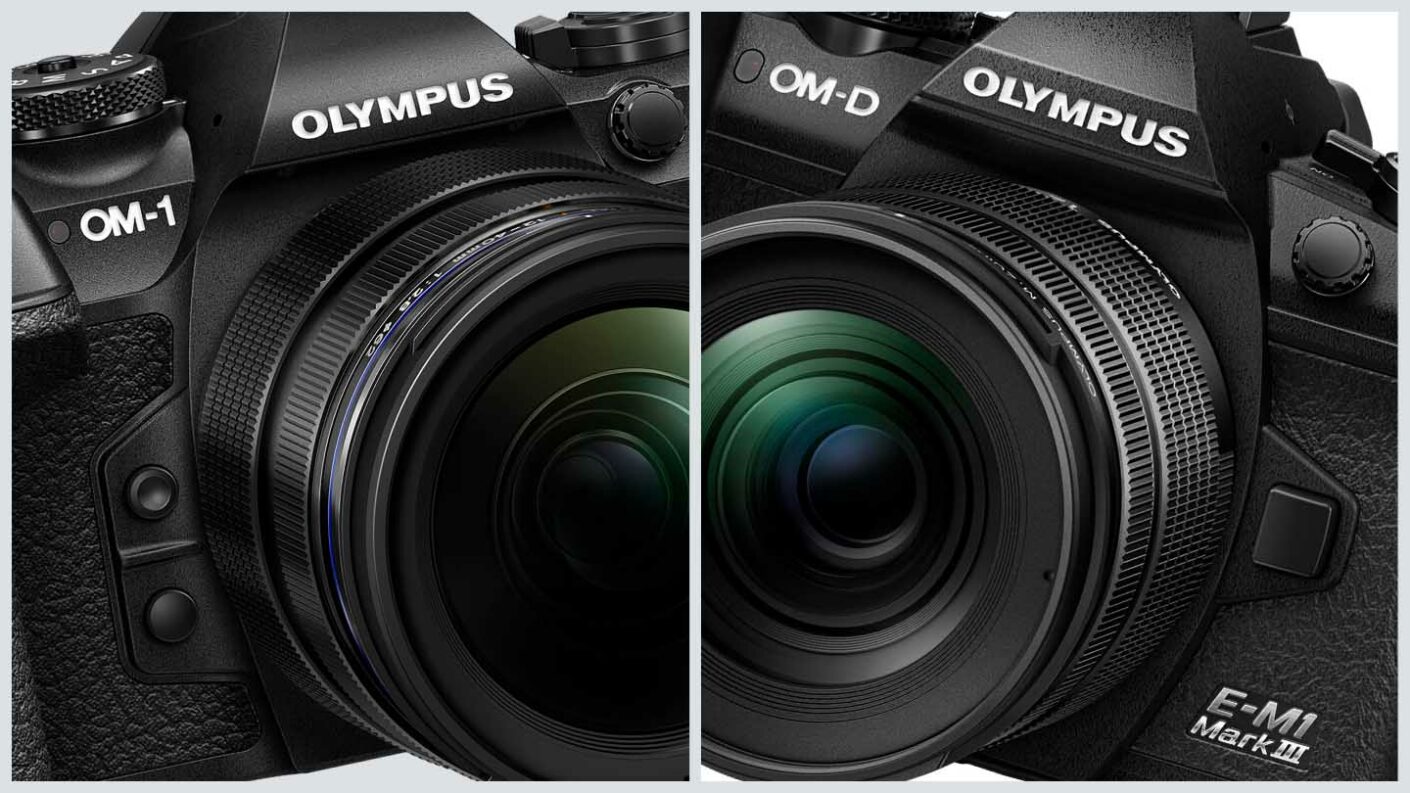OM Digital Solutions is the new owner of the camera company formerly know as Olympus, but it produces products under the brand name OM System. The OM System OM-1 is the first camera to appear under that brand name but for some reason, the company decided to put an Olympus name badge on the viewfinder housing. Perhaps it’s to underline the connection between the two brands? Who knows, but we’re told that the OM System OM-1 is the last camera that will feature the Olympus name.
While the Olympus OM-D E-M1 Mark III is set to continue for a little longer, the OM System OM-1 is its successor. It also leapfrogs the Olympus OM-D E-M1X in the company’s line-up to become the flagship camera in the Olympus / OM System range. Naturally, many Olympus E-M1 Mark III users are eyeing-up the OM-1 with a view to upgrading while owners of cameras such as the Olympus OM-D E-M1 Mark II and Olympus OM-D E-M5 Mark III may be interested in how the OM-1 and E-M1 III compare in case they fancy an upgrade.
In this post, we’ll take a look at some of the key features to see how the OM System OM-1 compares with the Olympus OM-D E-M1 Mark III.
Sensor
- OM System OM-1: 20.4Mp Stacked BSI CMOS
- Olympus OM-D E-M1 Mark III: 20.4Mp CMOS
While the OM System OM-1 doesn’t make any increase in pixel count over the Olympus OM-D E-M1 Mark III, the design of its Four Thirds type sensor makes a significant step up. Instead of having a regular design like the E-M1 III, the OM-1’s sensor is a stacked backside-illuminated (BSI) chip. This means that the photodiodes (aka pixels) occupy their own layer in the OM-1’s sensor and consequently, they gather more light than each pixel on the E-M1 III’s sensor. The readout speed of the OM-1 sensor is also faster and this plays a significant role in improving aspects such as the autofocus performance and rolling shutter effect.
Processor
- OM System OM-1: TruePic X
- Olympus OM-D E-M1 Mark III: TruePic IX
According to OM System, the TruePic X processing engine in the OM System OM-1 is 3x faster than the TruePic IX engine in the Olympus OM-D E-M1 III. That helps with the general performance of the camera by enabling faster computations to be made as well as more complex algorithms to be used.
The new sensor and processor combination in the OM-1 enable a sensitivity range of ISO 200-102,400 with low expansion settings of ISO 80 and ISO 100. This compares with ISO 200-25,600 (plus ISO 64 and ISO 100) on the E-M1 Mark III.
Continuous shooting
- OM System OM-1: 50fps with C-AF, 120fps with S-AF, 50fps or 120fps in Pro Capture Mode
- Olympus OM-D E-M1 Mark III: 10fps with C-AF, 15fps with S-AF, 18fps or 60fps in Pro Capture Mode
The OM System OM-1 makes a significant jump up in continuous shooting capability over the Olympus OM-D E-M1 Mark III. These faster shooting rates mean that it’s even easier to capture split-second moments, whether it’s a bursting balloon, a splash of water or a fleeting expression. The ability to shoot at 50fps with continuous AF is especially impressive.
OM System and Olympus call their cameras’ continuous shooting modes ‘Sequential shooting’ with Sequential High offering the fastest shooting rate but with the focus and exposure set at the start of the sequence. Sequential Low allows a slower shooting rate (50fps with the OM-1) but there’s continuous AF and exposure metering.
Pro Capture mode is a little different. It sets the camera to record images when the shutter button is half-pressed but only writes the images to the memory card when the shutter is pressed home fully. It writes a sequences of images from before and after the button is pressed home. It’s designed to help with capturing unpredictable action.
Autofocus system
- OM System OM-1: Hybrid AF with 1053 cross-type phase detection and 1053 contrast detection points
- Olympus OM-D E-M1 Mark III: Hybrid AF 121 phase detection and 121 contrast detection points
Another change brought by the OM-1’s new sensor is a quad-pixel AF system. This means that all of the 1053 phase detection AF points are cross-type. Cross-type AF points are more sensitive than the regular linear type, making the OM-1 better at picking up and focusing on a subject.
In addition, the OM-1’s AF system is 2EV more sensitive than the OM-D E-M1 Mark III’s as it functions at down to -8EV rather than -6EV.
Perhaps the best news, however, is that the OM-1 gains the AI-driven Subject Detection modes that were first introduced with the Olympus OM-D E-M1X. It means the camera is able to detect and focus on formula cars, motorcycles, airplanes, helicopters, trains, birds and animals (dogs and cats). OM System also says that the detection, tracking and responsiveness of the Face Priority/Eye Priority AF have been improved significantly.
Computational photography
- OM System OM-1: 5-second processing
- Olympus OM-D E-M1 Mark III: 15-second processing
Like the Olympus OM-D E-M1 Mark III, the OM System OM-1 has a collection of computational modes that enable the camera to perform beyond what we would normally expect. High Res Shot mode, for example, makes use of the camera’s sensor-shifting image stabilisation system to capture a series of images that are then combined to make a 50Mp image in Handheld mode or an 80Mp image in Tripod mode. Thanks to the new processing engine, the compositing stage takes 5 seconds with the OM-1 rather than 15 seconds with the E-M1 III.
Viewfinder, screen and controls
- OM System OM-1: 5.76M-dot OLED with 0.83x magnification
- Olympus OM-D E-M1 Mark III: 2.36M-dot LCD with 0.76x magnification
OM System has given the viewfinder of the OM-1 a significant boost in resolution, up from 2.36-million dots in the OM-D E-M1 III to 5.76-million dots. The magnification is also greater and the refresh rate has been boosted to 120fps to make a better viewing experience all round.
In addition, the resolution of the 3-inch vari-angle touchscreen on the back of the camera has been increased from 1.04-million dots on the E-M1 III to 1.62-million dots on the OM-1.
OM Systems hasn’t stopped there as the OM-1’s menu and Super Control Panel have also been refreshed to make them clearer and better organised.
There are also a few changes to the control layout including the addition of an AF-ON button for back-button focusing. Also, in stills mode, the video record button gives access to the High Res Shot mode options.
OM Systems has also changed the OM-1’s two control dials in comparison with the OM-D E-M1 III. Instead sitting above the camera body, they now protrude from it so only part of the dial is visible.
Weather-sealing
- OM System OM-1: IP53
- Olympus OM-D E-M1 Mark III: IPX1
Olympus OM-D E-M1 series cameras have a good reputation for withstanding poor weather but the OM System OM-1 takes things a step further with a weather-proof rating of IP53. That means that it should survive being dowsed by a jet of water. In comparison, the E-M1 Mark III’s IPX1 rating means it’s designed to cope with drips and splashes of water.
Video
- OM System OM-1: 4K (4096 x 2160) at up to 60p, Flat Picture Mode, OM‑Log400, HLG
- Olympus OM-D E-M1 Mark III: 4K (4096 x 2160) at up to 30p, Flat Picture Mode, OM‑Log400
OM Systems has upgraded the OM-1’s video specifications in comparison with the E-M1 Mark III’s with the ability to record 4K 10-bit video at up to 60p and Full HD video at up to 240p (the E-M1 III goes up to 120p in Full HD). It also supports H.264 8-bit, H.265 10-bit and Multi Frame Rate recording of clips over 30 minutes in duration.
There’s also the ability to output raw video at up to 12 bit 4:4:4 to the Atomos Ninja V or Atomos Ninja V+. Plus HLG (Hybrid Log Gamma) capability joins the Flat Picture Mode and OM-Log400 options.
Storage
- OM System OM-1: Dual SD type cards slots, both UHS-II
- Olympus OM-D E-M1 Mark III: Dual SD type cards slots, one UHS-II and one UHS-I
Although the Olympus OM-D E-M1 Mark III has two SD-type card slots, only one of them is UHS-II compliant, the other is UHS-I. The OM-1 improves on this with dual UHS-II card slots.
- Find the Lexar Professional 2000X SDXC UHS-II Gold series Card on Amazon.com and Amazon.co.uk
Battery
- OM System OM-1: BLX-1 – 520 images, 160 minutes video
- Olympus OM-D E-M1 Mark III: BLH-1 – 420 images, 140 minutes video
The OM system OM-1 comes with a new higher capacity battery than the OM-D E-M1 Mark III. The new BLX-1 has a capacity of 17Wh and in CIPA tests it enables up to 520 images to be captured on a single charge with the OM-1. That’s up from 420 images with the 12.8Wh BLH-1 in the OM-D E-M1 III.
Should I sell my Olympus OM-D E-M1 Mark III?
While a few people may be disappointed that the OM System OM-1 doesn’t have a higher pixel count than the Olympus OM-D E-M1 Mark III, it makes an extensive array of upgrades that are designed to appeal to the Olympus core audience. It’s compact like the OM-D E-M1 Mark III, with a vertical grip available separately for the those want one and it has a significantly improved autofocus system, faster continuous shooting and better weatherproofing. The viewfinder and screen also have higher resolution.
In short, the OM System OM-1 is an enticing upgrade on the Olympus OM-D E-M1 Mark III, but even more so for owners of the older OM-D E-M1 and OM-D E-M1 Mark II.
Sponsored: Thinking of selling your camera or lens to help finance an upgrade? Get a free instant quote from MPB and find out what your kit is worth. Selling your gear to MPB is easy and secure. Plus get free doorstep pickup and super-fast payment. We’re loved and trusted by more than 250,000 visual storytellers around the world and we’re rated excellent with five stars on Trustpilot. Buy. Sell. Trade. Create.




I am a beginner looking to take actions shots of kids playing sports ( my son plays soccer) What would you recommend for good quality pictures that is not $7000.00 🙂
Thank you!
Hi Lynette, there are lots of options but my first thought is the Sony A6600 as it has superb autofocusing that will get your subjects sharp: https://camerajabber.com/reviews/sony-a6600/